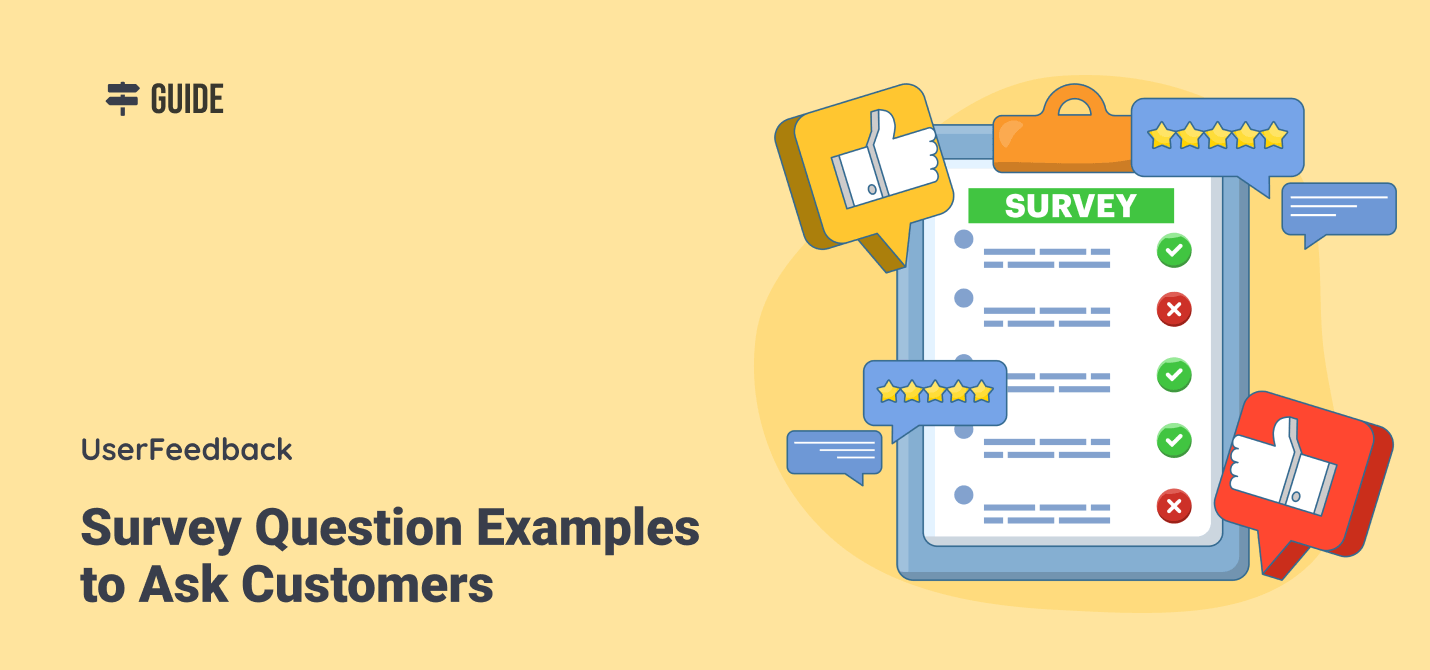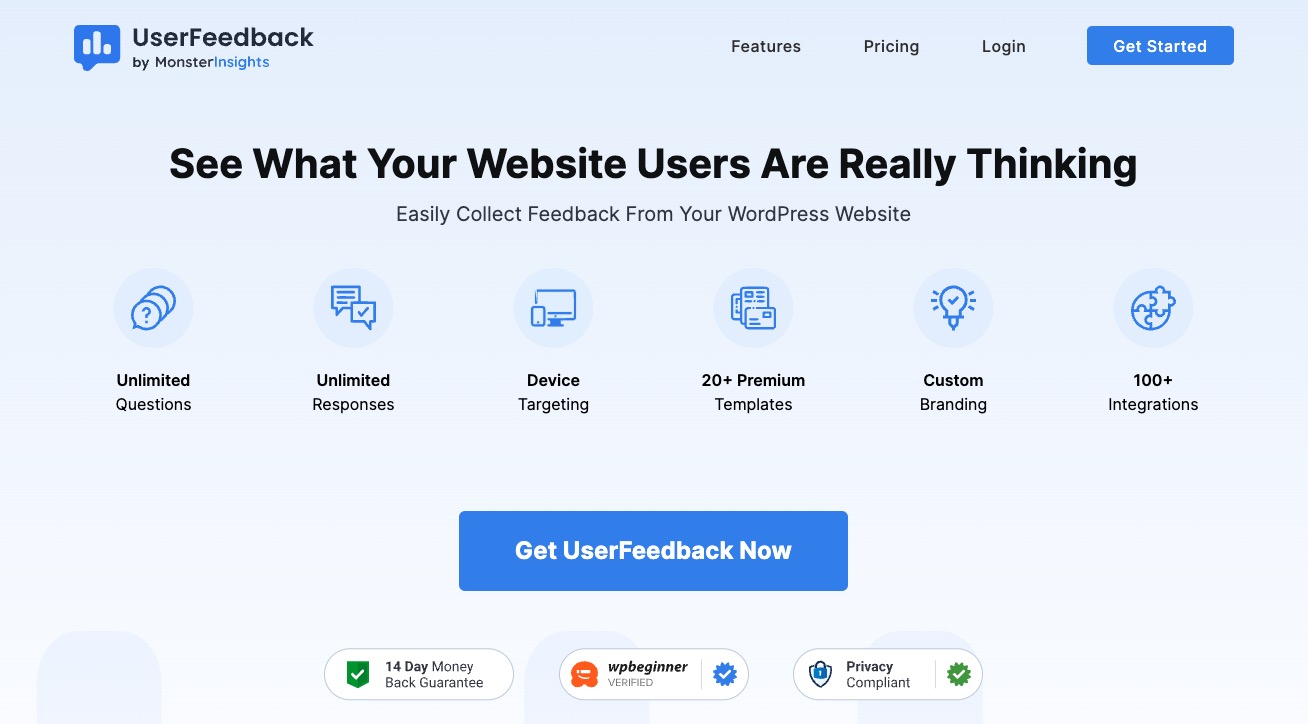Are you looking for awesome survey question examples to get helpful feedback?
You’re not alone! Figuring out what to ask your customers can be tough, and it’s easy to end up with disappointing answers. The trick is in the questions you ask and how you ask them—that really sets the tone for the feedback you’ll get.
So, in this guide, I’ll show you how to make amazing surveys that actually work. I’ll cover what makes a good survey and the different types of questions you can use, and I’ll share some powerful survey question examples for all sorts of goals.
Let’s get started!
Table of Contents:
- What Makes a Good Survey
- Main Types of Survey Questions
- Survey Question Examples to Ask Customers
- Best Survey Tool for WordPress: UserFeedback
What Makes a Good Survey
Before I dive into the different types of survey questions and examples, let’s talk about what separates a good survey from a not-so-great one.
A well-constructed survey provides insightful feedback, while a poorly designed one might leave you with unclear or unreliable results.
I’ve worked with customer insights and surveys for years, and I’ve seen some terrible mistakes that I want you to avoid making.
So here are a few best practices to help make a good survey:
- Keep it the right length: Not too long, not too short. Aim for enough questions to gather the necessary information without overwhelming people.
- Make it simple and easy to complete: Use clear and straightforward language so people of all backgrounds can understand and respond.
- Keep it focused: Target specific topics rather than covering everything at once. If needed, use separate surveys for different goals.
- Be neutral: Avoid leading questions that might influence the answers. Let people’s true opinions shine through.
By following these tips, you can craft engaging and useful surveys with high completion rates.
Want to learn more? Check out this full guide on How to Make a Good Survey.
Next, let’s explore the main types of survey questions you’ll want to consider!
Main Types of Survey Questions
Gathering feedback is a fantastic way to learn and grow your business. However, the feedback you collect heavily depends on how you ask the questions.
Becoming skilled at crafting the right questions is key to getting the best insights from your visitors.
Now, let’s explore the various types of survey questions you can use!
- Open-ended Questions
- Nominal Questions (Multiple-Choice)
- Dichotomous Questions (True/False/Yes/No)
- Likert Scale Questions
- Rating Scale Questions
1. Open-ended Questions
Open-ended questions let respondents share their thoughts in their own words, providing insights you might not get from standard options like multiple-choice or yes/no questions.
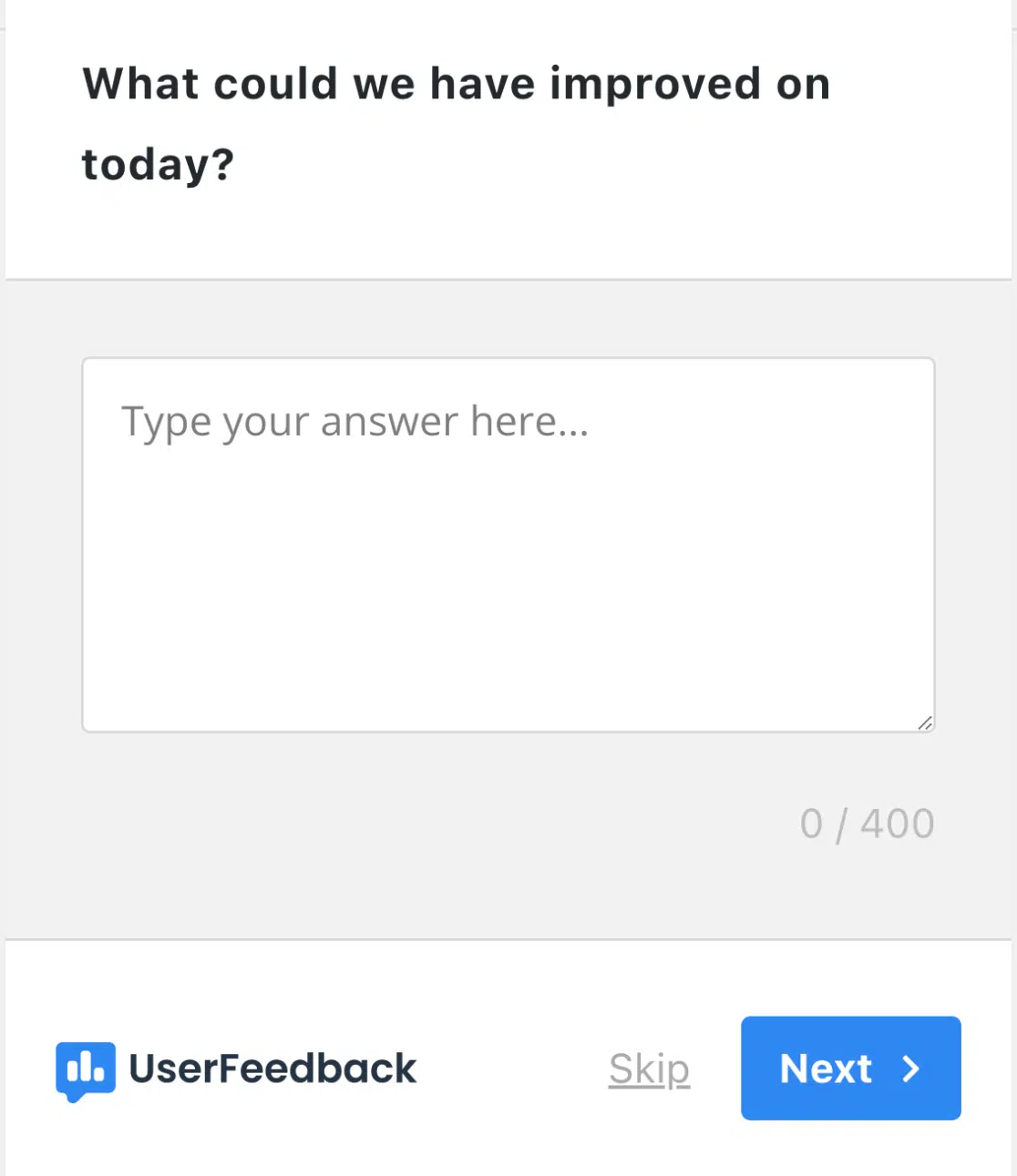
This type of question can uncover valuable insights that might otherwise be missed.
Examples of Open-ended Questions:
- What other products would you like to see us offer?
- If you could change just one thing about our product, what would it be and why?
Pros:
- Uncover detailed feedback and discover unexpected areas for improvement.
- Great for learning what your customers really want.
Cons:
- These questions take more time and thought to answer, which can lower response rates.
- The data is harder to analyze than straightforward yes/no answers and takes more time.
When to Use Open-ended Questions
Use open-ended questions to explore deep insights into customer needs and experiences.
However, they should be balanced with closed-ended questions to combine rich feedback with easy-to-analyze data.
For instance, after asking about a customer’s satisfaction score, follow up with, “What was the main reason for your score?” This approach gives you both the specifics and the big picture, making your survey more effective.
2. Nominal Questions (Multiple-Choice)
Nominal (or multiple-choice) questions present respondents with a set of predefined answer options, allowing them to select one or more responses.
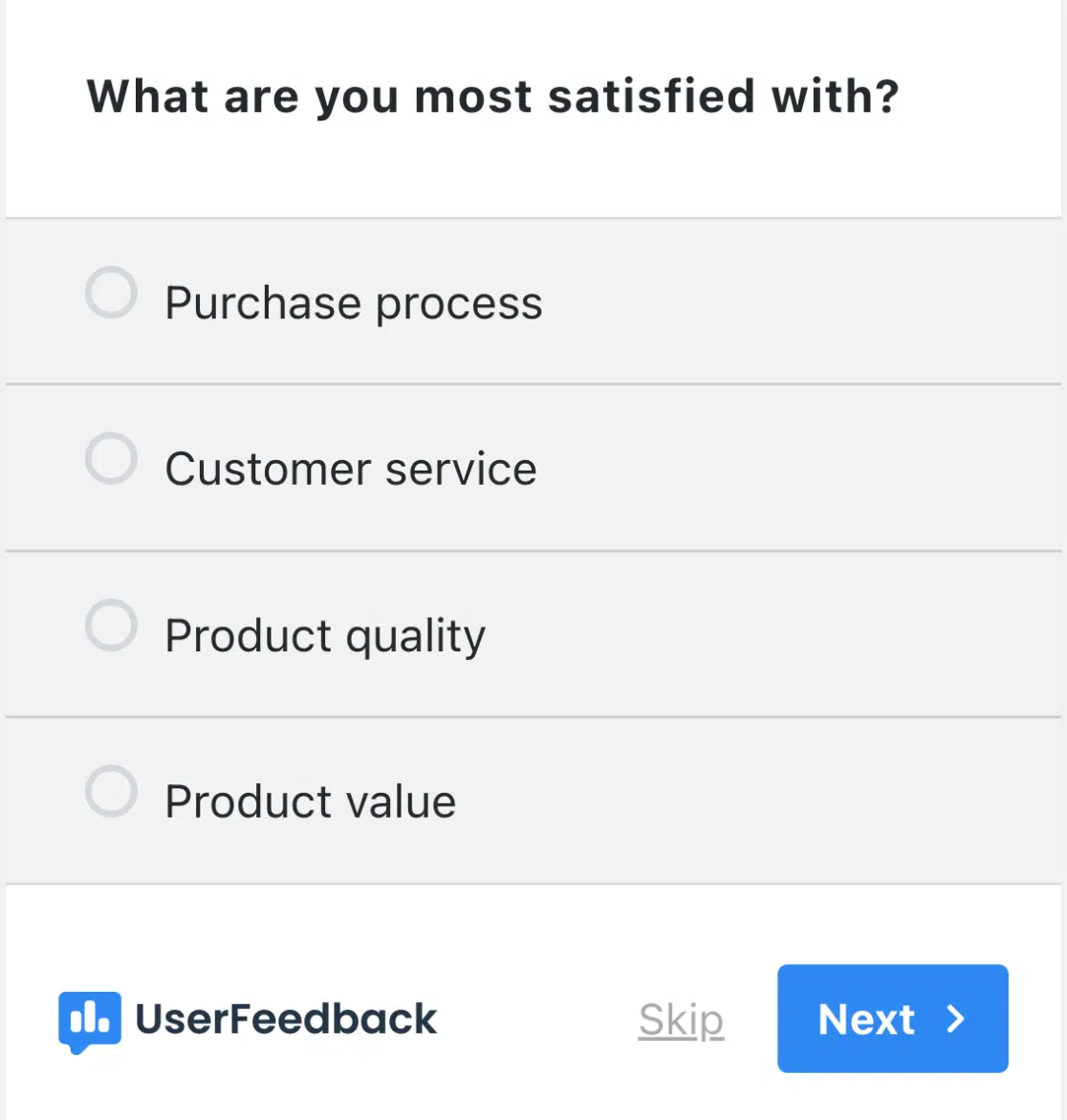
These questions are one of the most common and effective ways to gather data that is straightforward to analyze.
Example of a Nominal Question:
What are you using [product name] for?
- Business
- Personal use
- Both business and personal use
Pros:
- Saves time and effort for both respondents and researchers.
- Simplifies the data analysis process by organizing responses into clear categories.
- Helps in easily creating graphs and identifying trends.
Cons:
- It can introduce bias if the provided options do not fully capture all possible answers.
- Doesn’t provide the deep “why” behind responses.
When to Use Nominal Questions
Nominal questions are perfect for situations with a limited number of distinct categories, as seen in the example above.
They’re excellent for generating structured responses that can be easily interpreted and used to identify patterns or trends.
However, if you’re worried about missing out on other potential answers, consider including an “Other, please specify” option. This addition allows respondents to provide a unique answer, giving you rich data while maintaining the convenience of multiple-choice options.
3. Dichotomous Questions (True/False/Yes/No)
Dichotomous questions are as straightforward as they come, offering respondents just two choices.
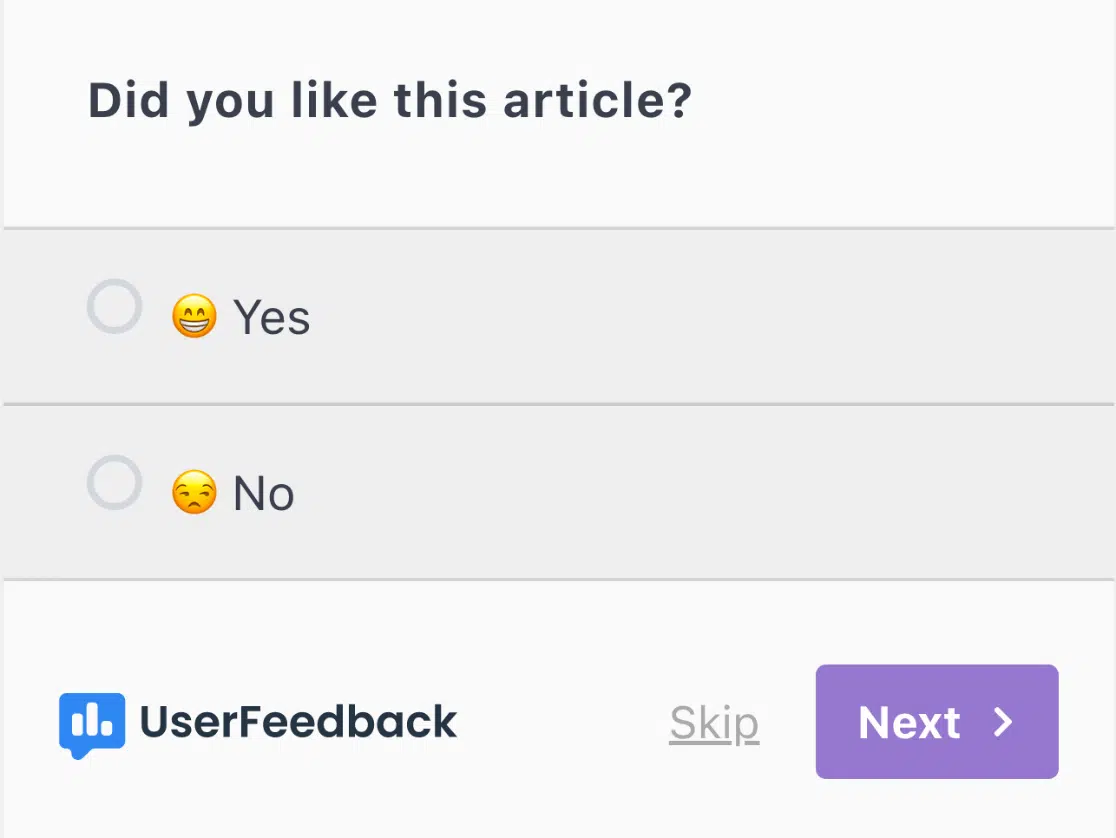
These questions are characterized by their binary nature, which simplifies the decision-making process and allows respondents to provide quick answers.
Example of Dichotomous Questions:
Do you find our product easy to use?
- Yes
- No
True or False: Our customer service met your expectations.
- True
- False
Pros:
- Easy and quick for respondents to answer.
- Simplifies data analysis with clear-cut, binary results.
- Useful for questions where only two possible states or conditions exist.
Cons:
- Limited in the depth of information they can provide.
- May oversimplify complex opinions or experiences.
When to Use Dichotomous Questions
Dichotomous questions are ideal when you need straightforward responses. They’re perfect for filtering respondents based on criteria or for initial screening questions.
Use them when the information you seek can be effectively captured with a simple yes/no or true/false distinction.
When deeper insights are required, dichotomous questions should complement other question types that allow for more detailed responses.
4. Likert Scale Questions
Likert scale questions research how strongly respondents feel about a particular statement by letting them choose from various options.
These typically range from one extreme to another, such as “strongly agree” to “strongly disagree.”
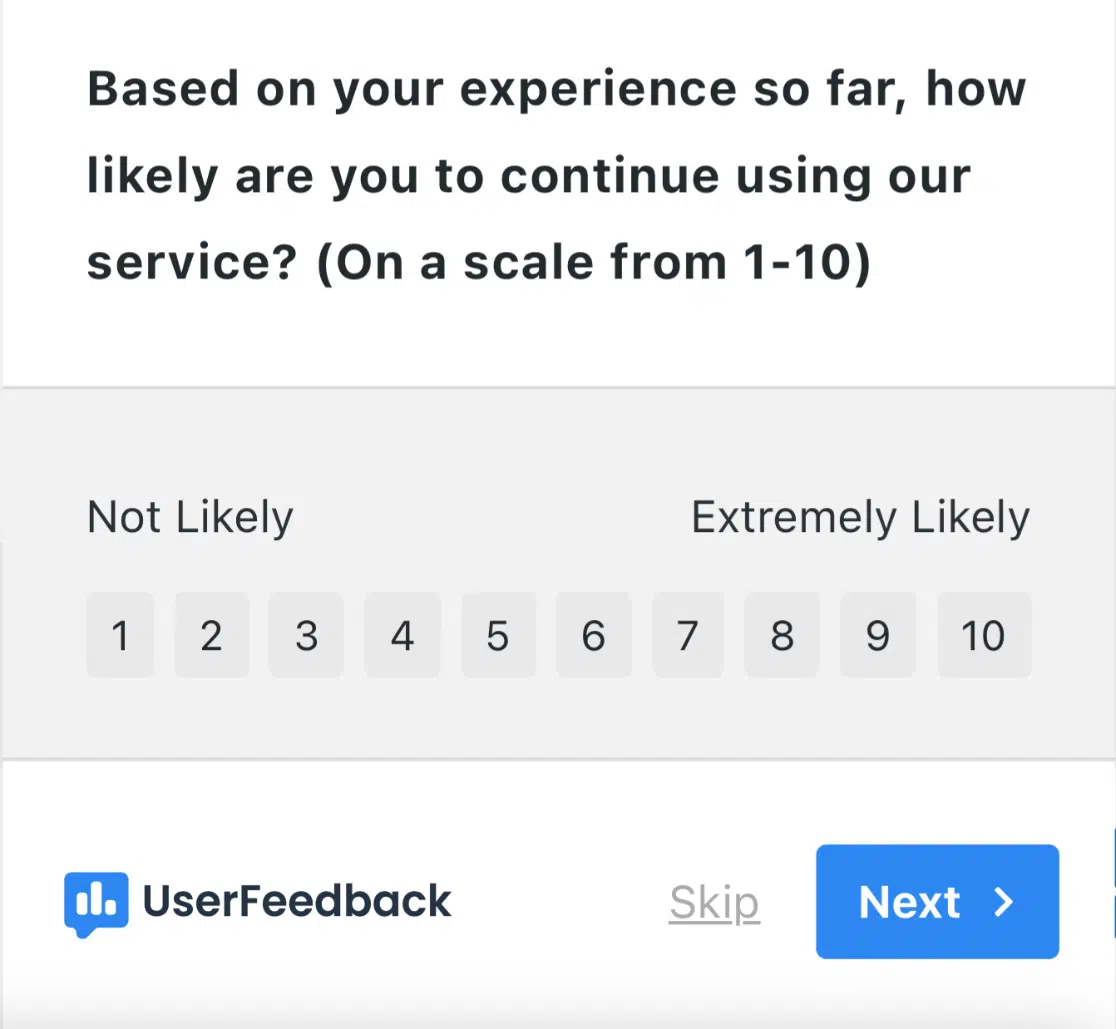
Example of a Likert Scale Question:
The culture of my workplace is good and healthy.
- Strongly disagree
- Disagree
- Neutral
- Agree
- Strongly agree
Pros:
- Respondents find these questions simple and quick to answer.
- Capture levels of opinion and subtle differences in respondents’ attitudes.
- Data from these scales is easy to analyze and can indicate trends and patterns.
Cons:
- Respondents might select the middle option, which can lead to skewed data.
- Doesn’t provide insight into why respondents feel a certain way.
When to Use Likert Scale Questions
These questions are ideal for understanding opinions or feelings on specific topics, especially when you want more detail than a simple yes/no answer can provide.
They are particularly useful when you have some idea of your customers’ thoughts from previous open-ended questions or feedback.
For example, if you get a general complaint about a new feature, a Likert scale question can help determine just how widespread and intense those feelings are.
5. Rating Scale Questions
Rating scale questions invite respondents to assign a numeric value to their experience or opinion, making them ideal for quantifying feedback.
These scales can vary, such as rating customer support from 1 to 5, giving something stars, or the likelihood of recommending a product from 0 to 10.
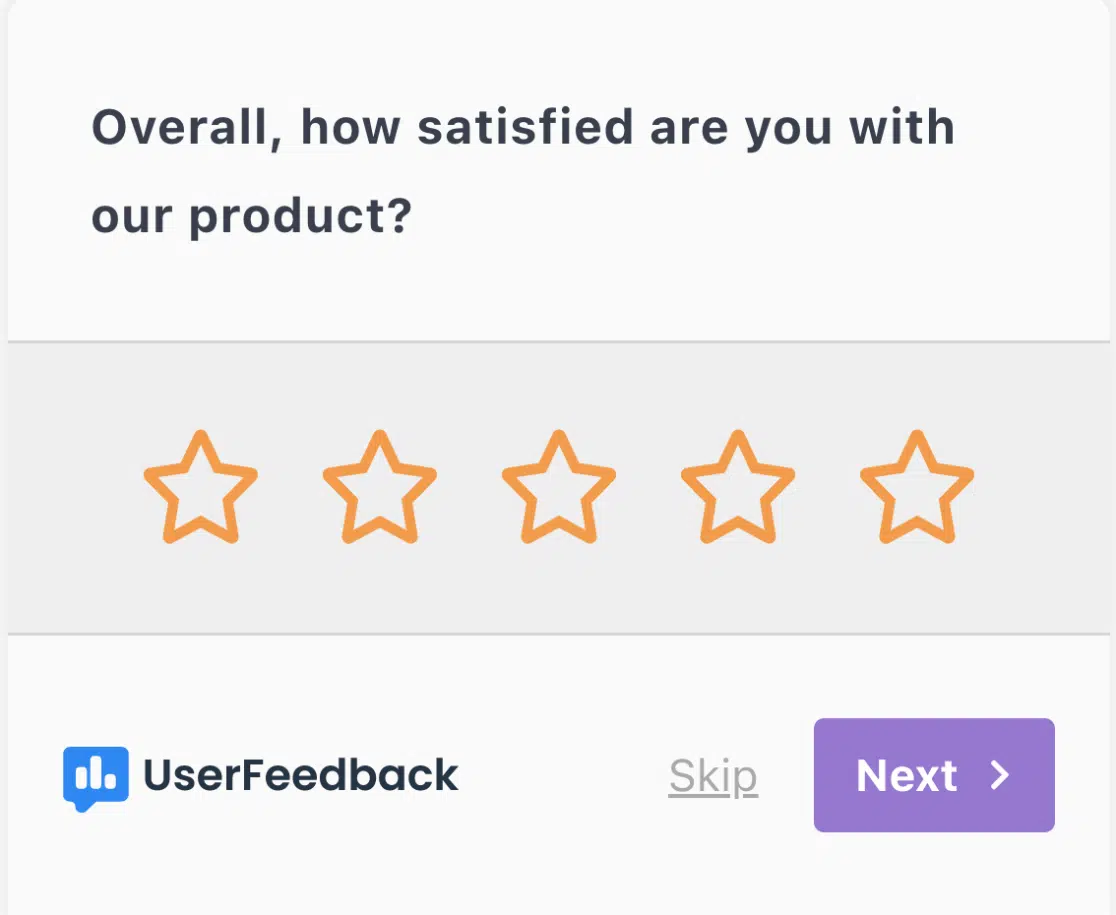
Examples of Rating Scale Questions:
- How happy are you with our product?
- How would you rate our customer service on a scale of 1-5?
Pros:
- Easy for respondents to understand and complete quickly.
- Produces straightforward, quantifiable data.
- Consistently using the same questions allows you to monitor improvements or declines.
Cons:
- Doesn’t explain why a particular score was given.
- Different respondents may interpret the same values differently.
When to Use Rating Scale Questions
These questions are excellent for scenarios where you want to numerically measure satisfaction or probability levels.
They’re often used to calculate Net Promoter Score® (NPS®), which assesses how likely customers are to recommend your products or services.
They’re also common in customer satisfaction (CSAT) surveys and product reviews.
When designing rating scale questions, be sure to clarify what each point on the scale represents (e.g., 1 being ‘Poor’ and 5 being ‘Excellent’).
Additionally, consider asking a follow-up open-ended question to understand why a particular score was chosen.
Pro Tip: Avoid providing a middle choice to encourage more decisive responses, which can lead to more useful data. For instance, using a 6-point scale instead of 5 can push respondents to make a clear choice rather than opting for the neutral one in the middle.
That wraps up the most common types of survey questions!
Remember, a great survey blends different types of questions to keep your respondents engaged and gather meaningful feedback.
Now, let’s dive into some powerful survey question examples you can use in your next survey.
Survey Question Examples to Ask Customers
Now, let’s get further into the good parts of this guide.
I’ll demonstrate some useful and powerful survey question examples designed for different purposes. These questions can help you gather valuable insights and improve customer engagement and satisfaction.
We’ve broken them up into these categories:
- Customer Satisfaction Surveys
- Post-Purchase Surveys
- Product Improvement
- Feature Requests
- Market Research
Let’s dive into each category to see which questions can help you get the most out of your surveys!
1. Customer Satisfaction Surveys

Customer satisfaction surveys are essential tools used to see how happy customers are with your products or services.
They help you understand what’s working well and identify areas for improvement to enhance customer experience and loyalty.
Survey Question Examples:
- On a scale of 1-5, how satisfied are you with our product? (Rating Scale)
- How likely are you to recommend our product or services to a friend or colleague (Likert Scale)
- What can we do to improve your experience? (Open-ended Question)
- What are you most satisfied with? (Dichotomous Question)
Read our full guide on How to Create a Customer Satisfaction Survey.
2. Post-Purchase Surveys
Post-purchase surveys are conducted after a customer completes a purchase.
They are designed to gather feedback on the purchasing process, initial product impressions, and overall satisfaction with the transaction.
Survey Question Examples:
- How would you rate your checkout experience? (Rating Scale)
- Did you find the product descriptions helpful? (Dichotomous Question)
- How did the product live up to your expectations on a scale from 1-10 (Likert scale)
- Was there something we could have done better? (Open-ended question)
Read our full list of 60+ Effective Post-Purchase Survey Questions to Ask Buyers.
3. Product Improvement
Product improvement surveys are designed to collect customer feedback on current products and identify areas for enhancement.
They help you understand customer needs and preferences, allowing you to refine and update your products for better market fit.
Survey Question Examples:
- What features do you find most valuable in our product? (Open-ended Question)
- On a scale of 1-10, how effective is [product] in meeting your needs? (Rating Scale)
- Are there any features you feel are missing? (Open-ended Question)
- How often do you use our product? (Nominal Question)
- Is there anything that frustrates you about our product? (Open-ended Question)
4. Feature Requests
Feature request surveys focus on collecting user suggestions about new features they’d like to see in a product.
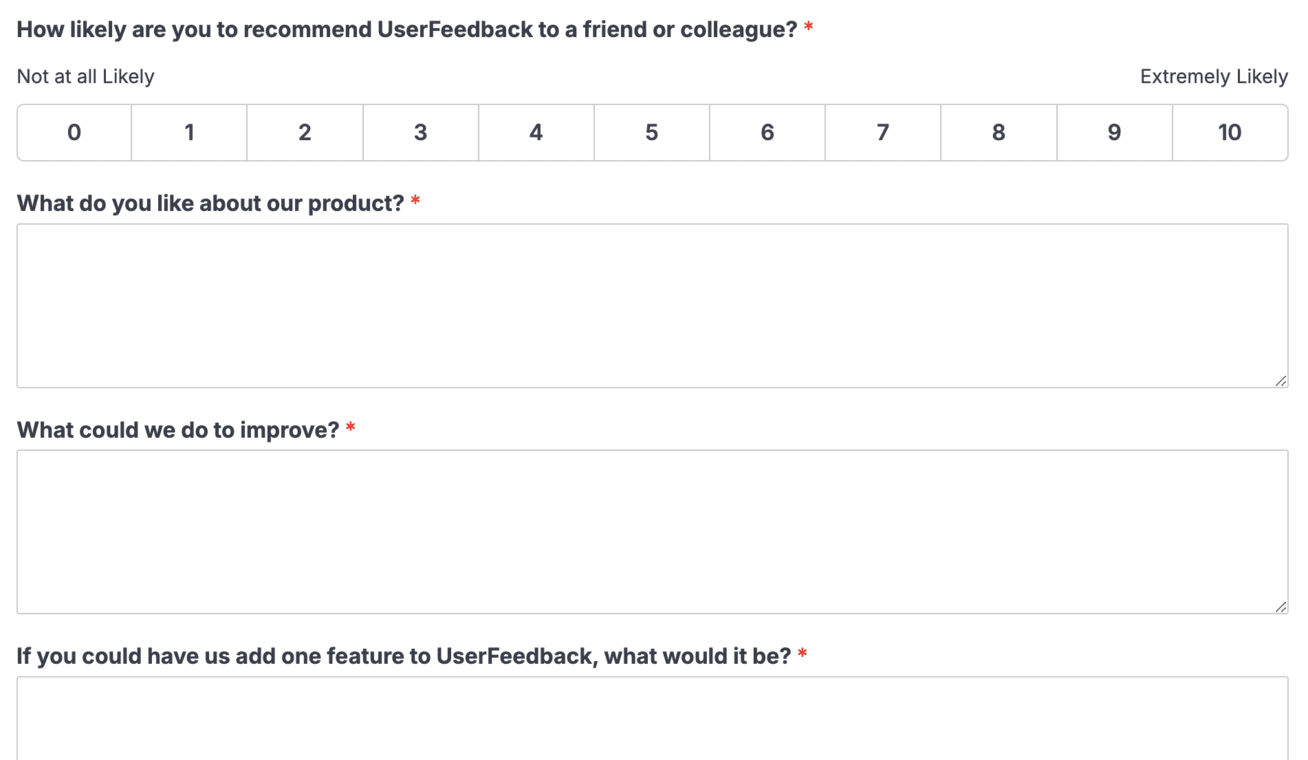
These surveys help prioritize development based on what your customers actually want and appreciate.
Survey Question Examples:
- How important is [specific feature] to you? (Rating Scale)
- Which of these features are most important to you (Nominal Question)
- Would [hypothetical feature] improve your experience with our product? (Dichotomous Question)
- How likely are you to use [specific feature] if implemented? (Likert Scale)
- If you could have one new feature, what would it be? (Open-ended Question)
5. Market Research
Market research surveys aim to collect data about consumers’ needs, preferences, and behaviors.
These insights are vital for understanding market trends and making informed business decisions.
Survey Question Examples:
- What factors influence your purchasing decisions the most? (Nominal Question with an open-ended “Other?”)
- How often do you purchase [product category]? (Nominal Question)
- Which brands do you currently prefer and why? (Open-ended Question)
- On a scale of 1-10, how satisfied are you with the current options available in the market? (Rating Scale)
- What do you currently feel is missing? (Open-ended Question)
- How much are you willing to pay for [type of product]? (Nominal Question)
6. User Experience Feedback
User experience feedback surveys aim to understand how users interact with your website, app, or product and identify areas for improving usability and experience.
Survey Question Examples:
- How easy was it to navigate our website or app? (Rating Scale)
- Did you encounter any issues while using our product? (Dichotomous Question)
- On a scale of 1-5, how would you rate the design and layout of our platform? (Rating Scale)
- What did you enjoy the most about using our product? (Open-ended Question)
- Are there any areas where you feel we could improve? (Open-ended Question)
Best Survey Tool for WordPress: UserFeedback
Now that you know how to craft effective surveys and have a ton of epic survey question examples, it’s time to use that knowledge and gather insightful feedback from your audience.
The best survey tool for WordPress? Look no further than UserFeedback!
UserFeedback is the top user feedback plugin for WordPress. It provides powerful features to engage your visitors easily and get the honest answers you need.
It’s intuitive and comes with pre-set questions, yet flexible enough to let you create your own custom questions.
Key Features of UserFeedback:
- Unlimited Surveys and Responses: Create as many surveys and questions as you need without limits.
- Pre-made Survey Templates: Use easy templates for website feedback, customer satisfaction surveys, post-purchase experience surveys, and much more.
- Customization: Personalize surveys with your website’s colors and logo for a seamless look.
- Conditional Logic: Adjusts based on previous responses to keep the questions relevant.
- Variety of Question Types: Use open-ended, multiple choice, star ratings, and more.
- Targeted Display: Control when and who sees your surveys for maximum impact.
- Integration and Reporting: Works smoothly with Google Analytics through MonsterInsights, providing clear reports and saving all responses for easy access.
With all these features, UserFeedback makes collecting and analyzing user feedback simple and effective, helping you enhance your WordPress site and better satisfy your visitors.
That wraps up this complete guide and overview of the best survey question examples for valuable feedback.
I hope you found this guide useful and learned a lot about gathering user insights. Maybe you’d also like to read:
- Best User Feedback Tools to Get Excellent Feedback
- How to Ask For a Review (12 Best Ways + Examples)
- How to Get and Improve Your Customer Effort Score
And don’t forget to follow us on X and Facebook to learn more about collecting user feedback online.
